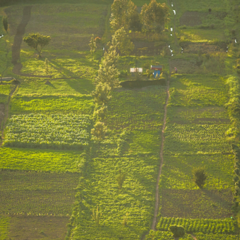Global Climate Action Summit 2018

Global Climate Action Summit 2018
David Lobell and Marshall Burke Talk Food Security, Human Health and the Importance of Mitigation
When it comes to food security, health and poverty, the impacts of climate change already are evident. That’s the message FSE Fellows David Lobell and Marshall Burke delivered last week at Global Climate Action Summit events held by Stanford in San Francisco. Attendees from across the globe gathered at the summit aimed to mobilize commitments and action from local governments, corporations and NGO’s to mitigate climate change and reach the goals of the Paris Agreement.
Lobell and Burke – a professor and assistant professor (respectively) in Earth system science in Stanford’s School of Earth, Energy & Environmental Sciences participated in the Stanford Woods Institute for the Environment sponsored panel on Sept. 14 “The 2009 EPA ENDANGERMENT FINDING: EVEN STRONGER EVIDENCE in 2018.” Moderated by Stanford Woods Institute Director Chris Field, the panel examined how new research bolsters the original report’s findings that greenhouse gases pose a threat to human health and welfare.

“This isn’t just about the future, we’re seeing impacts around the world right now,” Lobell said.
Supporting Lobell’s statement is the newly released 2018 State of Food Security and Nutrition in the World (SOFI) report authored by the FAO. For the third year in a row global hunger is on the rise and, unlike previous years, climate change takes a front seat – along with conflict and violence – to attributable causes of both increased global hunger and as a catalyst for severe food crises across the globe. This is notably due to extreme climate events (such as floods, droughts, hurricanes, and fires) having doubled since the 1990s, damaging agricultural productivity, reducing food availability and incomes.
Climate change is proving to adversely impact not only agricultural output, but also nutrition across the globe. A recent study by Lobell, Burke, and co-authors examined the impacts of increased carbon dioxide concentrations (a direct driver of global warming) on crop nutrients. They found zinc and iron concentrations lowered in some crops, leading to a rise in the global health burden of zinc and iron deficiencies along with their associated diseases.
This is disproportionately true in South-East Asia and sub-Saharan Africa, two areas already known for having some of the highest rates of undernourishment. Their study also found that the most effective way to alleviate this risk is by meeting the proposed Paris Agreement mitigation strategies rather than relying on traditional public health interventions.

Burke, who has also focused several studies on examining the societal impacts of climate change warned “we’re barely scratching the surface of the major outcomes we may care about.”
He went on to detail the aspects a rising temperature has on daily life he has studied, including lowered worker productivity, cognitive ability, and economic output. But, that isn’t all, Burke has also discovered a correlation between rising temperature and human violence. He found that increased temperatures led not only to increased human violence toward others, but also result in more self-harm.
Burke explained a recent study he led examining the impacts of a warming globe on suicide rates across the US and Mexico. The team found a strong correlation between warming weather and increased suicides, concluding that as climate change leads to increased temperatures, suicide rates will also rise.
Continuing the focus on climate impacts on human health, Lobell also participated on a children’s health panel, hosted by the Center for Climate, Health, and the Global Environment at the Harvard T.H. Chan School of Public Health, the Sean N. Parker Center for Allergy and Asthma Research at Stanford University, and the Stanford Center for Innovation in Global Health.
Laying the foundation for concern, Lobell outlined the impacts of food insecurity on children’s health as 46 percent of child mortality under the age of five is due to undernutrition.
Lobell stressed that food quantity and quality are important to consider. Both chronic hunger (defined as lack of sufficient calories and protein) and hidden hunger (defined as lack of sufficient micronutrients) are drivers of malnutrition and impacted by climate change.
“In food security it isn’t just about producing the foods, but also making sure people have the ability to access the food through incomes and other means,” Lobell said.
Looking at future projections, Lobell explains that for some areas of the world (think cold regions such as Russia or Northern Europe) there may be a short-term benefit to increased carbon dioxide concentrations and temperatures. However, he warns in most places the associated climate changes more than offset the benefits, resulting in a negative effect for a majority of the global population.
“Because the tropics are more warm to start with, generally more burdened with climate stresses especially in the subtropics, you get most of the negative impacts occurring there and this is the area of the world where most of the undernutrition and malnutrition is occurring,” Lobell said.
Lobell suggests solutions which include deepening commitments to traditional interventions such as nutrient supplements, agricultural productivity, strengthened pre and post-natal care, and sanitation. He also stresses the importance of (you guessed it) minimizing climate change.
Coverage of the event
Stanford Radio Interview "The Future of Everything with Marshall Burke"
Climate affects human health and behavior in ways we’re only beginning to understand, Marshall Burke says. The Stanford economist sits down with Stanford School of Engineering’s Russ Altman for a closer look at the implications of warmer and more extreme weather.
Related research











